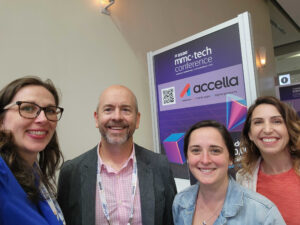Nothing sets the business world on fire like the entry of a new generation into the workforce. It seems like just yesterday when millennials were the subject of corporate ire as we maliciously “killed” dozens of industries while forcing organizations to freshen up to attract and retain top young talent. Maybe it’s because, as a millennial, I still remember the experience — or perhaps because I am young enough to be considered a “Zillennial” (whatever that means) — but I find this new wave of organizational discourse on Gen Z quite irksome.
Despite your feelings or widespread accepted generalizations of this cohort, one thing is for sure — Gen Z will force organizations to adapt yet again. Although the exact year range varies by source, the Pew Research Center says members of Gen Z were born between 1997 and 2012. By that definition, Gen Z will comprise the next decade of college graduates.
For associations to stay relevant and thrive in the future, it’s crucial to adapt to and invest in younger generations. This investment is a win-win for associations and younger members. By providing the right benefits and opportunities to recent grads, associations can prove their value to a cohort who lost career development opportunities due to the pandemic and the rise of remote work, while benefiting from fresh perspectives and diverse experiences. To meet the needs of this new generation, associations need to spend the time and do the legwork to truly understand this demographic and tailor benefits messaging specifically toward Gen Z.

Big Yikes – Attitudes Towards Associations and Unions are Changing
According to a report by the Pew Research Center, membership in labor unions and professional associations has been declining in the United States for several decades. In 1983, union membership among U.S. workers stood at 20.1%, but by 2020, that number had fallen to 10.8%. Similarly, professional association membership declined from 23% in 2001 to 16% in 2020.
The decline in membership is due to a variety of factors, including a shift toward temporary and part-time work, changes in the economy and job market, and a generational shift in attitudes toward membership in organizations. Despite the decline, however, associations and unions continue to play an essential role in advocating for workers’ rights and providing support and resources to their members. The role of associations as a resource is particularly relevant as Gen Z continues to enter the workforce.
OK Boomers (and Gen X and Millennials) – Talk to the People
According to a study by the American Society of Association Executives (ASAE), the average age of association CEOs is 55.8 years old. Additionally, many associations hire more experienced marketers, meaning entry-level folks may not always be a part of an association’s day-to-day operations. With little to no representation in association administration, associations need to engage in audience research to understand better what Gen Z members and potential members need from them.

To effectively engage with and understand what Gen Z finds valuable, associations should make a concerted effort to — surprise — actually talk to them. Knowing this group is likely already underrepresented in membership, email surveys are an ineffective way to gather information. Surveys can sometimes miss the nuances of their experiences.
Instead, opt to get in front of them – consider a focus group at a local university or community college, or reach out to member organizations in the area to see if they have Gen Z talent they could lend you for a lunch-and-learn. In-person, social sessions can alleviate the pressure of 1-1 interviews and reduce the likelihood of over-generalizing information from one person to an entire group. Although this kind of research can be time-consuming, it is well worth it for associations to better position themselves for success for years to come.
No Cap – Build Better Value Messaging
Many associations make one of two mistakes with value messaging. They either fail to connect their extensive list of benefits to the value the benefits provide to members or they provide high-level value messaging in a way that prospective members don’t understand what they are getting. When armed with research and a strong understanding of Gen Z as a collective audience, associations can better connect benefits to member value and create digital experiences explicitly tailored for Gen Z. For example, your association’s legislative wins, while important, likely won’t hit the mark with entry-level recent grads the way it does with members in senior leadership.

What if your benefits don’t align with what Gen Z needs? If younger members are not getting any value out of the association, it’s time to take stock of why and take action to address them. Some examples involve creating more relevant programming and events and offering different resources deemed beneficial to younger members. By doing so, the association can attract and retain younger members and provide them with the support and resources they need to succeed in their careers.
Meet Them Where They Are, Not Where You Think They Should Be
To engage with this new wave of potential members, associations must leverage the communication channels Gen Z already uses. Traditional communication methods like email or the web may be less effective than social platforms. Unlike consumer brands, associations and other B2B organizations have yet to make the full jump onto platforms like Instagram, Snapchat, TikTok, and YouTube. But to reach Gen Z and beyond, this will have to change.

Unlike organizations that use these platforms to drive sales or convey a brand image, associations can use social media to tap into and contribute to existing digital communities. By understanding the communication channels younger generations use most heavily and identifying existing, relevant online communities, you can reach new potential members in a more informal setting.
Don’t Be Cringe – Low-Pressure Networking is a Necessary Benefit
One of the most valuable things associations can offer younger generations is the opportunity to network and build relationships in non-traditional ways. With the rise in remote work, natural networking opportunities during the workday are becoming less frequent, and regardless of generation, traditional networking events can be challenging.

Take the pressure out of networking by offering informal yet lightly structured events, such as happy hours or coffee meetups. Do the legwork to recruit experienced members for these events to help Gen Z connect with potential mentors. Other opportunities include virtual workshops and networking opportunities that allow members to engage with each other across geographic boundaries. By facilitating networking and relationship building in these non-traditional ways, associations can help younger members make the connections they need to advance their careers.
Stop Telling Them to Make Coffee At Home – Make Membership More Affordable
According to a report by the National Bureau of Economic Research, members of Generation Z (born 1997-2012) face higher living costs than previous generations. This discrepancy is due to rising housing costs, healthcare expenses, and education costs, all of which make it more difficult for Gen Z members to become financially independent and save for the future.

With that in mind, the financial burden of joining a professional organization can feel unattainable for recent grads and will not win against other items in the budget, especially if the perceived value is nonexistent. Associations should explore new pricing models such as stair-stepped pricing, monthly subscriptions, or membership scholarships. With the help of technology and a little creativity, associations can reduce the friction to sign up.
Exploring different models can also benefit current members, especially considering nearly 30 percent of associations ask members to renew their membership during Q4 when the holidays have more folks feeling strapped for cash.
Conclusion
Associations should aim to be the go-to resource members can turn to, regardless of how early they are in their careers. If you haven’t started to adapt to attract Gen Z members, now is the time. It’s essential to remember that this generation differs from Millennials in some significant ways, and their needs and preferences should be considered when designing an acquisition and retention strategy.
The sooner associations adapt to better support Gen Z, the sooner they can start planning for Gen Alpha, who will be the subject of corporate confusion before we know it. By being proactive and adapting to the changing needs of these generations, associations can position themselves as the organization of choice for young professionals and ensure their continued success and the success of the industries and communities they serve.





